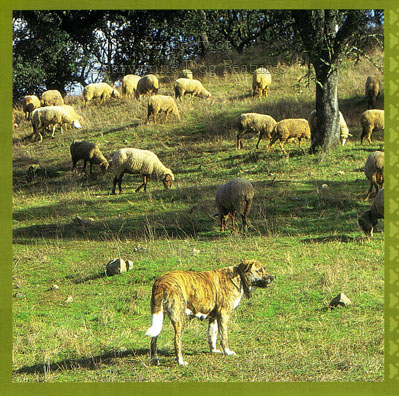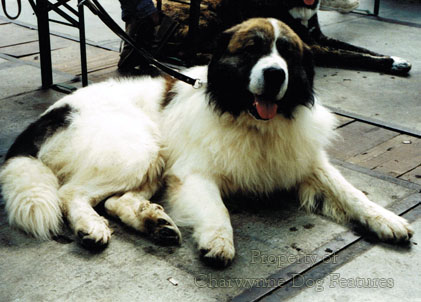591 Shepherd's mastiff
REMEMBERING THE SHEPHERD'S MASTIFF
by David Hancock
 From Iberia in the west, across to the Levant and on to the Caucasus mountains in the east, from southern Greece through Hungary to northern Russia there are powerful pastoral dogs to be found, developed over thousands of years to protect man's domesticated animals from the attacks of wild animals. Some are called shepherd dogs, others mountain dogs and a few dubbed 'mastiffs', despite the conformation of their skulls. Their coat colours vary from pure white to wolf-grey and from a rich red to black and tan. Some are no longer used as herd- protectors and their numbers in north-west Europe dramatically decreased when the use of draught dogs lapsed. A number of common characteristics link these widely-separated breeds: a thick weatherproof coat, a powerful build, an independence of mind, a certain majesty and a strong instinct to protect. As a group, they would be most accurately described as the flock guardians; in Britain in the distant past they were referred to as 'Shepherd's Mastiffs'.
From Iberia in the west, across to the Levant and on to the Caucasus mountains in the east, from southern Greece through Hungary to northern Russia there are powerful pastoral dogs to be found, developed over thousands of years to protect man's domesticated animals from the attacks of wild animals. Some are called shepherd dogs, others mountain dogs and a few dubbed 'mastiffs', despite the conformation of their skulls. Their coat colours vary from pure white to wolf-grey and from a rich red to black and tan. Some are no longer used as herd- protectors and their numbers in north-west Europe dramatically decreased when the use of draught dogs lapsed. A number of common characteristics link these widely-separated breeds: a thick weatherproof coat, a powerful build, an independence of mind, a certain majesty and a strong instinct to protect. As a group, they would be most accurately described as the flock guardians; in Britain in the distant past they were referred to as 'Shepherd's Mastiffs'. 
In south-west Europe these dogs became known in time as breeds such as the Estrela mountain dog and the Rafeiro do Alentejo of Portugal and the Extremadura 'mastiff' of Spain. To the north- east of the Iberian peninsula, such dogs became known as the Pyrenean Mountain Dog and, separately, as the Pyrenean 'Mastiff' .In the Alps they divided, as different regions favoured different coat colours and textures into the 'sennenhund' or mountain pasture breeds we know today as the Bernese, Appenzell, Entlebuch and Great Swiss mountain dogs and the St Bernard. In Italy, local shepherds favoured the pale colours now found in the Maremma sheepdog and the very heavy coat of the Bergamasco. In the Balkans, similarly differing preferences led to the emergence of the all-white Greek sheepdog and the wolf-grey flock guardians of the former Yugoslavia. 
Further east, other breed-types were stabilised into the Kuvasz and Komondor of Hungary, the Rumanian sheepdog, the Tatra mountain sheepdog of Poland, the Slovakian Kuvasz, the Mendelan of north Russia and the Owtcharkas of south Russia and the Caucasus. In the Himalayan regions appeared the so- called Tibetan 'Mastiff', the Bhotia, the Bisben, the Bangara 'Mastiff', the Koochi or Powinder dog of Afghanistan 'and the Powendah dog of north-west Pakistan. In central Europe, breeds like the Bouvier (meaning drovers' dog) des Flandres, Bouvier des Ardennes, Bouvier de Roulers, Bouvier de Paret, Bouvier de Moerman, (with only the Flanders and Ardennes dogs surviving), the Giant Schnauzer and the Hovawart emerged. In Scandinavia the long-extinct Dahlbo-hound, the size of an English Mastiff, was used to guard cattle in forest pastures. Whilst where Europe and Asia meet, breeds now referred to as the Anatolian shepherd dog, Akbash and Kangal dogs developed.
The huge and often quite fierce pastoral dogs of Russia have yet to attract widespread favour beyond. Russian breeds like the Borzoi and the Samoyed have long been admired outside their native country and are now very much part of the global dog show world. But the flock guardians or owtcharkas from Central Asia, the Caucasus and Southern Russia, now the Ukraine, despite appearing at world dog shows, are not widely favoured. These distinct breeds are powerful, assertive and very protective dogs of some stature but not exactly pets in our sense of the word. There were plenty at the 1998 Helsinki world dog show; some were very resentful of other dogs, many being muzzled, even in the ring. Several were 32 inches at the withers.
The Caucasian sheepdog is very much like the Karst or Istrian sheepdog, the Sarplaninac or Illyrian sheepdog and similar to the brindle form of the Spanish Mastiff. There are, not surprisingly given the distances involved, different varieties of the Caucasian dog: the massive thickset type from Checheno- Ingush, NE of the Caucasus, the taller lighter type from Azerbaijan in the south-east towards Azarbayjan-e-Sharqi in Iran, the smaller squarer type of Dagestan, east of the Caucasus, and the big rangier Kangalian from the border area between Georgia and Turkey. Some experts claim that the best and most uniform specimens actually come from Georgia. Their restriction to these remote areas has led to these dogs being largely unknown in the West. They are becoming better known in eastern European countries and in the USA, where they became recognised, as the breed of Caucasian Mountain Dog, by the United Kennel Club in 1995.
If you lined up a Caucasian Owtcharka, a Karst, a Sarplaninac, a Spanish Mastiff, an Estrela Mountain Dog, an Anatolian Shepherd Dog and a St Bernard, in a brindle or wolf-grey coat, you could soon see how function decided form in such breeds, as well as how very similar in type they are. This, despite the immense distance from the Atlantic in the west to the Caspian Sea in the east. If you lined up parti-coloured specimens of the Rafeiro do Alentejo from Portugal, the Pyrenean Mastiff, the Pyrenean Mountain Dog, the Anatolian Shepherd Dog, the St Bernard and the Caucasian Owtcharka, again the similarities would be startling. To do their work as flock guardians, mountain dogs or steppe dogs have to have thick, weatherproof coats, size and substance, great stamina and robustness and a strongly-developed protective instinct. 
In Britain once the wolf had been exterminated, the need for flock guardians or shepherd's mastiffs disappeared, but all over Europe, strapping herding dogs continued to be favoured, if only to protect flocks and herds being driven to distant pastures and markets from human threats and village curs. The drovers of Britain used the Smithfield Sheepdog, what became the Old English Sheepdog and in Wales the Welsh Hillman. Artists like Reinagle, Landseer, Roos, Cuyp and Pillement depicted these protective pastoral types, leaving us with some concept of their conformation. Some of the fiercer ones became involved in the European stag, wolf and boarhunts, not as hounds but as expendable 'catch-dogs', sacrificed at the kill to save more valuable hounds. Hondius, Oudry, Snyders and de Vos all captured both the ferocity and the canine sacrifice in such employment.
The ease of modern living has led to our devaluing the contribution made throughout human history by the flock protectors, but our ancestors prized them and developed them as highly impressive extraordinarily robust canine specimens. We must be careful with the surviving breeds not to substitute show-ring criteria for functional need. Huge cow-hocked, straight-stifled, over-coated, under-muscled shepherd's mastiffs would not have lasted long in the demanding pastures of past centuries. Our respect both for our rural heritage and those breeds surviving man's changing requirements needs to be demonstrated by a seeking of soundness before stance and fitness ahead of flashiness. These quite remarkable faithful selfless admirable dogs deserve no less.